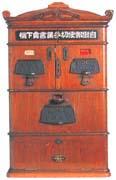| Contents
REPORT #1
Introduction
REPORT #2
What They provide
REPORT #3
Why So Popular?
REPORT #4
Using The Machines
REPORT #5
A Brief History
REPORT #7
Photo Essay
REPORT #8
TIMEasia.com Article
|
REPORT #5
Vending machines: A
Brief History
 There were 5,500,400 vending
machines in Japan in 1998, according to
one survey. They brought in total revenue
of 6,896,948,870,000 yen! This figure is
higher than that of any other country,
yet Japan does not have the most vending
machines. That honor belongs to the
United States, which recently had 6.89
million of them, according to a 1997
survey. But Japan has the highest number
per capita-one for every 23 people, as
opposed to one for every 35 people in the
U.S. There were 5,500,400 vending
machines in Japan in 1998, according to
one survey. They brought in total revenue
of 6,896,948,870,000 yen! This figure is
higher than that of any other country,
yet Japan does not have the most vending
machines. That honor belongs to the
United States, which recently had 6.89
million of them, according to a 1997
survey. But Japan has the highest number
per capita-one for every 23 people, as
opposed to one for every 35 people in the
U.S.
The world's first vending
machine was manufactured in the 3rd
century BC. It sold holy water at a
shrine in Egypt to anyone who put in a
coin. In the 17th century, an English pub
installed a machine that sold pipe
tobacco. Japan's first practical machine
was made in 1904. It was an automated
device selling postage stamps and
postcards, and was attached to a mailbox.
Vending machines came into
their own in Japan after World War II.
Machines dispensing juice in paper cups
became a hit in the 1950s. Then a large
American soft drink company introduced
its models in 1962, revolutionizing the
distribution industry. Vending machines
received a tremendous boost in 1967, with
the minting of 100-yen coins, which
joined coins of smaller denominations. |

Japan's first vending
machine sold stamps and postcards.
(Courtesy of
Communications Museum) 
|
|
|